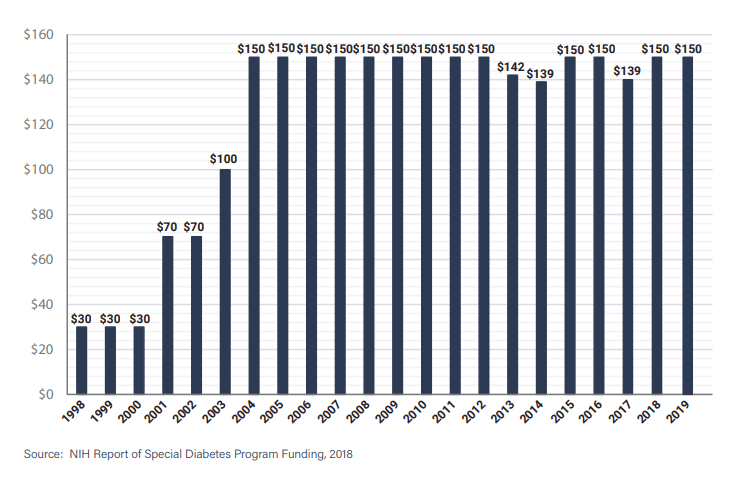This report provides an overview of type 1 diabetes research funding at the National Institutes of Health (NIH) in 2018. All diabetes-related research funding projects are listed on the NIH’s publicly available website (click here to view). In preparing this report, the JDCA reviewed and categorized all NIH grants into three district categories: type 1 focused; type 2 focused; and general diabetes (see Appendix A for more details on category definitions). The type 1 diabetes numbers are inclusive of funds provided by the Special Diabetes Program for T1D, which was $150 million in both 2016 and 2018. See Appendix B.
The main finding from this analysis, as shown in the chart below, is type 1 focused research funding was decreased by half between 2016 and 2018.

Key Highlights:
- The NIH spent a total of $1 billion on diabetes research in both 2016 and in 2018
- Type 2 focused research increased by +$240 million (from $419m to $659m), while, at the same time, both type 1 focused research and general diabetes research declined.
- Type 1 focused research was cut in half between 2016 to 2018, from $320 million to $168 million. (As noted above, these numbers include the Special Diabetes Program for T1D).
- General Diabetes research decreased from $322m to $200m.
- When asked for comment, the NIH stated that the information provided on their website is factual and current.
The decrease of T1D funding and relocation of funds to T2D funding has become increasingly common across the diabetes research ecosystem. Unfortunately, this analysis reveals a significantly more substantial shift away from T1D funding, as compared to prior years, than previously understood. This is a major concern for all of the T1D community.
The only government source of funding for type 1 diabetes research now appears to be the Special Diabetes Program, accounting for $150m of the $168m spent on type 1 focused research in 2018 (compared to $150m out of $320m in 2016). This analysis suggests that the continuation of this program is critical to ensure that type 1 research continues to receive dedicated focus from the NIH. A vote to renew the fund for five years by Congress will be held in September. We fully support the renewal of this program.
In order to restore NIH T1D research funding, we as a T1D community must speak loudly, clearly, and above all as a unified voice. For donors, this means actively voicing a desire for an increase in T1D research funding directly to your state and federal representatives as well as advocates like the ADA and JDRF. For the major T1D non-profits, restoration of T1D funding can only come from an acknowledgment, instead of obfuscation, of the decline and immediate tracking and public dissemination of NIH T1D funding trends.
Appendix A: Definitions
- Total Diabetes: The total amount the NIH allocated to diabetes-related research. (This includes type 2, type 1, and general diabetes).
- Type 1: Projects which solely conduct type 1 diabetes-related research. Examples include the artificial pancreas, type 1 diabetes immune system, and beta cell functioning.
- Type 2: Projects which solely conduct type 2 diabetes-related research. Examples include obesity, diet, and type 2 specific complications.
- General Diabetes: Projects which include both type 1 and type 2 research. Examples include complications, insulin, and base epidemiological research.
Appendix B: NIH Special Diabetes Program Funding (in millions)

